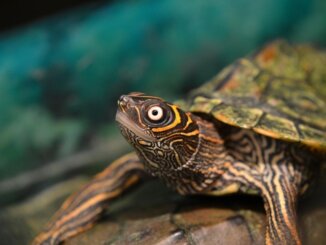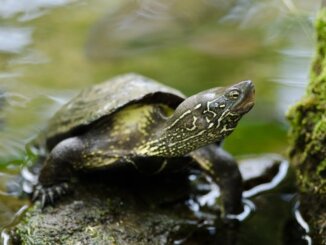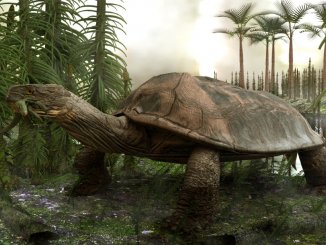The mata mata turtle is a large, triangular-headed turtle that originates from South America. Mata mata turtles are sedentary freshwater creatures that require a lot of space and the right water parameters. For this reason, mata mata turtles aren’t recommended for beginner reptile keepers.
Mata Mata Turtle Overview
| Common Name | Mata mata turtle, mata-mata turtle, matamata turtle |
| Scientific Name | Chelus fimbriata |
| Natural Habitat | Freshwater, slow-moving backwater streams in South America, including Brazil, Peru, Venezuela, Ecuador, Bolivia, Colombia, and Island of Trinidad |
| Adult Size | 18 inches |
| Average Lifespan | Up to 15 years |
| Diet | Carnivore |
| Housing | 45×45-inch tank, 75–90°F, slightly acidic water with a depth of 8 inches |
| Experience Level | Intermediate to expert |
Origin
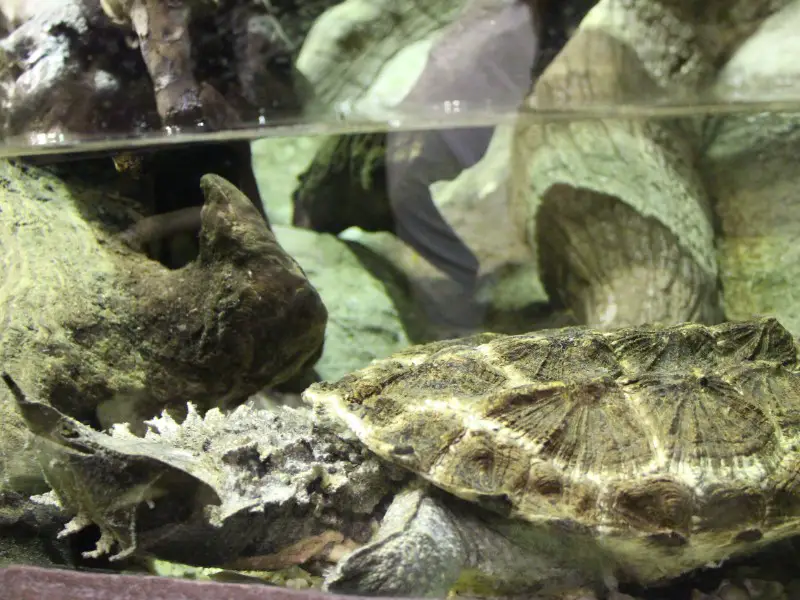
The mata mata turtle (Chelus fimbriata) is found in slow-moving freshwater and backwater streams, rivers, and swamps in parts of South America, including Colombia, Peru, Brazil, Venezuela, Ecuador, and Bolivia. The turtle is also found on the Island of Trinidad.
In the wild, mata matas are a strictly aquatic turtle species. However, mata matas are not well-adapted to swimming in water. The turtles prefer to stand in water that is shallow enough for them to lift their snouts and breathe from the air above.
Appearance and Behavior
Mata matas have a striking, unique appearance that some people find ugly. The turtle’s shell is rough, flat, and nobbly, and the skin of the neck has ridges and bumps. The large, flat head of the mata mata turtle is triangular-shaped, and the turtle has a long, snorkel-like snout.
The carapace (the top of the shell) is dark brown, while the underside of the mata mata is yellow or brown. The shell of the mata mata is usually covered in algae due to the turtle’s lack of activity, and helps the turtle to blend in with its environment.
The mata mata’s legs, head, and tail are covered in grayish brown skin, and the turtle has webbed feet with five claws on the front feet and four claws on the back feet.
Because mata mata turtles have poor eyesight, parts of the turtles’ bodies act as sensory aids. The fleshy flaps on the sides of the head and neck contain nerves that respond to vibrations of approaching potential prey.
Male mata mata turtles have concave plastrons (undersides) and thicker tails than females.
Size and Lifespan
The mata mata turtle can grow up to 24 inches long. Full-sized adults in captivity grow to 16–20 inches, and there’s no difference in size between males and females.
The lifespan of a mata mata turtle in captivity is up to 15 years. In the wild, mata matas have been known to live beyond 30 years.
Temperament
Mata mata turtles are sedentary creatures that live solitary lives aside from when they’re breeding. These turtles rarely swim, and spend most of their time standing in shallow waters.
Mata matas prefer to be left alone, so although the turtles aren’t territorial and rarely show aggressive behavior, you should house them independently.
If you’re looking for a pet to handle, the mata mata turtle isn’t suitable for you. This turtle doesn’t appreciate being pulled out of the water and can be snappy.
Housing Mata Mata Turtles
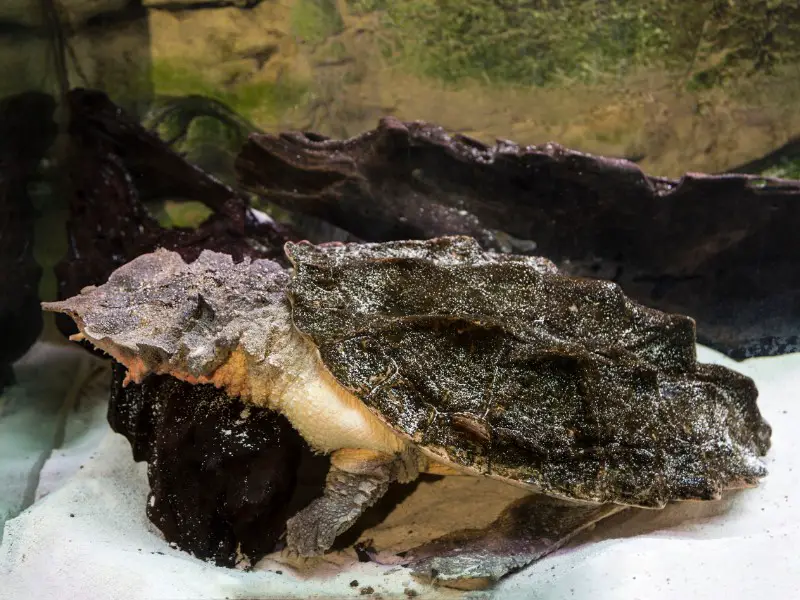
In the wild, mata mata turtles live in shallow, slow-moving freshwater streams, swamps, and rivers in tropical regions. Replicate this environment in captivity with a heated tank and enough water for your mata mata to explore.
House mata matas in a large vivarium.
Enclosure size
Hatchling or juvenile mata matas require a 60-gallon tank with a water depth of 4 inches. Mata matas grow quickly and, as adults, mata mata turtles need a tank of around 100 to 150 gallons, primarily consisting of water.
For adult mata matas, make sure the tank contains at least 10 gallons of water per inch of turtle. Water depth should be 10 inches, and the length and width of the body of water should be at least 48 inches.
Lighting
Lighting is essential for the growth of a mata mata turtle, and a lack of light can stress the turtle and lead to health problems.
A UVB bulb should be used in the enclosure and replaced as necessary (usually every six months). Install the lighting in the center of the vivarium’s roof to provide even light around the enclosure. Use a high powered, compact fluorescent UV bulb to make sure the light rays can penetrate water. Mata matas spend a lot of their time submerged.
Mata matas require between 10 and 12 hours of UVB light per day. Set the light on a 12-hour timer, switching on during the day and switching off during the night, to stimulate the day-night cycle.
Temperature and Humidity
Mata matas are tropical turtles, so make sure the enclosure is as warm as the turtle’s natural environment.
Although mata mata turtles don’t spend much time basking, a heat lamp is still an important element of the tank. A 75- to 150-watt heat bulb, set to emit temperatures of 93–97°F, should be positioned about 12 inches above a dry basking spot.
The temperature of the water, and the parts of the enclosure not directly underneath the heat lamp, should be between 75 and 85°F. If the heat lamp in the basking area doesn’t provide adequate heat for the whole enclosure, install a ceramic heat emitter or an aquarium heater and use a thermometer to check that the temperature remains consistent.
Mata matas don’t require specific equipment, such as misters, for increasing tank humidity. The humidity from the water in the warm enclosure is sufficient.
Substrate and Decoration
In the wild, mata mata turtles are used to sandy, soft substrates. Replicate this in the enclosure with a sandy or pebbly substrate that is comfortable for the turtle to walk across.
Avoid abrasive rocks or pebbles in the substrate because these could scrape the underside of the turtle and cause injury. Smooth-pebble gravel is fine.
Although mata matas spend almost all of their time in water, you should still have a dry spot in the enclosure. Add a smooth rock or a large log to the basking area, or make a basking island in the pond.
Aquatic and artificial plants provide hiding places for mata mata turtles and reduce stress. The best plants for a mata mata enclosure are deep-rooted plants like anubias and java fern.
Water features like waterfalls are appealing to mata matas. Use a piece of wood to block the flow of the water from disturbing the water in the pond.
Because mata mata turtles sleep in water, there’s no need for a dedicated sleeping spot in the tank.
Cleaning
Keeping the enclosure clean is essential for the health and happiness of your mata mata turtle.
Most of the tank is made up of water, so water changes and filtration are two essential cleaning requirements. Use a large, powerful filter in the tank, ensuring that the filter is powerful enough for the enclosure size. Check the filter and remove any shedded mata mata skin and waste to prevent blockages.
Filtration should remove waste and keep the water clean, but you still need to change the water regularly. Once a week, carry out a partial water change, changing one-third of the water in the tank. It’s fine to leave the mata mata turtle in the tank during water changes.
Every two weeks, examine the tank for waste and shedded skin. If necessary, wipe down plant leaves and clean the basking spot. This should be a quick job because mata matas rarely spend time on dry land.
Mata Mata Turtle Care
Mata mata turtles are easy to feed and care for, but they aren’t suitable for people who don’t have the space for a large, water-based enclosure, or the funds to feed a large turtle.
Food and Water
Mata mata turtles are carnivores, and eat fish, aquatic worms, and insects in the wild. You should mimic this diet as closely as possible in captivity. Commercial turtle diets aren’t nutritious or sustaining enough for mata mata turtles.
Feed mata mata turtles a combination of live prey, such as earthworms, guppies, minnows, goldfish, mollies, and muscles. Mata matas suck fish into their mouths like a vacuum. Because mata matas have weak jaws, the turtles require food that can be swallowed whole.
Allow mata matas to feed freely by keeping the enclosure well-stocked with around 40 food items at all times. Mata mata turtles are slow-moving, so providing plenty of food spread throughout the enclosure will prevent this turtle from struggling to feed. Top up the tank when there are less than 30 food options available.
Juvenile mata mata turtles follow a similar diet to adults, and live food should be small enough to fit in the turtle’s mouth. Earthworms and feeder fish — inexpensive fish like guppies and mosquitofish, which are often used as prey — are ideal foods for young mata matas.
Common Health Issues
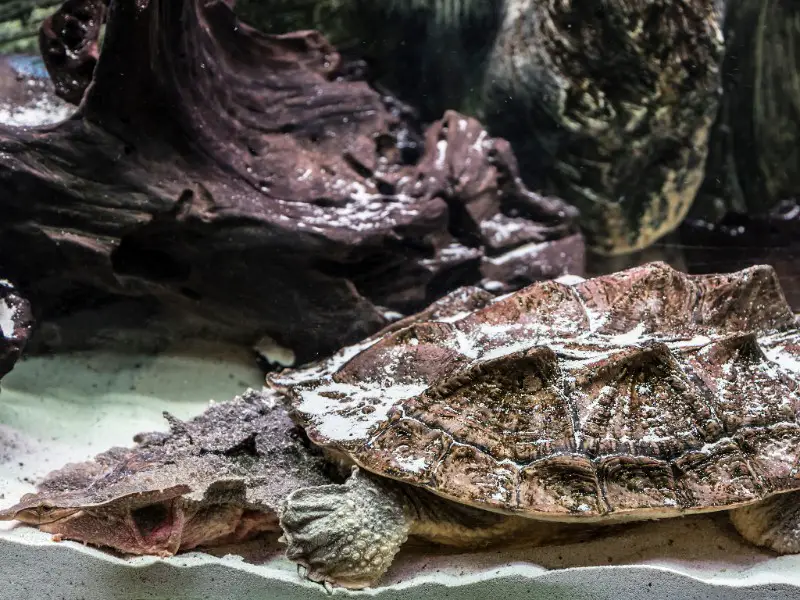
There are several common health issues that affect mata mata turtles. Most of these issues are caused by poor feeding or poor tank conditions and can be avoided by maintaining a good tank environment.
Nutritional Diseases
The nutrients the mata mata turtle receives are strongly related to what the turtle eats. If you don’t feed mata matas high-quality live foods, the turtle won’t obtain the nutrients it needs to grow. A lack of nutrients causes mata matas to become more inactive than usual and affects growth rate. Prevent nutritional diseases by providing an ongoing selection of high-quality foods for the turtle to eat.
Respiratory Infections
If a tank isn’t humid or warm enough, mata mata turtles are at risk of respiratory infections. The symptoms of a respiratory infection include swollen eyelids, breathing through the mouth, and a runny nose. Prevent respiratory infections by ensuring the tank’s temperature is warm and humid, using a thermometer to ensure consistent temperatures.
Parasite Infections
Because mata mata turtles eat a diet of live foods, parasitic infections are common. Parasites are passed from fish to turtles when the turtles eat the fish. Worms and amoeba are common parasites that affect mata mata turtles. If you notice vomiting, diarrhea, or weight loss, contact your veterinarian for antibiotic treatment.
Shell Trauma
While the mata mata’s shell looks hard and sturdy, damage from knocks, bumps, and scrapes can cause trauma to the turtle. Prevent shell damage by ensuring the tank conditions are safe, with no steep climbing areas that the turtle could fall from and no abrasive surfaces that could scrape the turtle’s shell.
Supplements
Mata mata turtles should get the bulk of their nutrients from their food. However, there are several supplements that can be used alongside a healthy, varied diet to support the turtle’s health:
- Vitamin D supplements promote a healthy shell, healthy bones, and healthy skin
- Calcium supplements prevent metabolic bone disease
- Vitamin A supplements prevent vision problems and upper respiratory infections
Add supplements to a mata mata turtle’s tank once per day or as advised by the manufacturer.
Breeding
In the wild, mata matas breed and lay eggs between October and November. Egg laying takes place in open, sandy spaces, and eggs incubate for about 200 days before hatching.
Captive-breeding mata mata turtles isn’t common amongst hobbyists. Most people don’t have enough space for a large tank that can house two mata matas.
Because of the lack of information available about breeding mata matas, breeding these turtles isn’t recommended for non-professional breeders.
Choosing and Buying a Mata Mata Turtle
The cost of a mata mata turtle is $250–$550. Buy mata mata turtles from reputable breeders or trusted online reptile stores.
Due to the mata mata turtle’s unique look, this turtle isn’t commonly available. It’s legal to buy imported mata mata turtles, but it is better to choose a captive-bred mata mata to prevent negative impacts on the turtle’s native environment.
When choosing a mata mata turtle, view the turtle in person before buying to ensure the turtle is healthy. Check that the turtle has a hard, smooth shell with no defects. Inspect the turtle’s head, making sure the eyes are clear and free of discharge or mucus.

